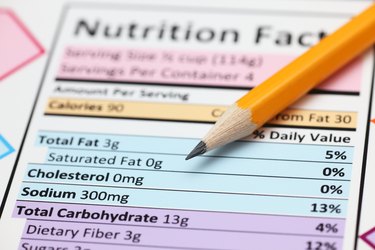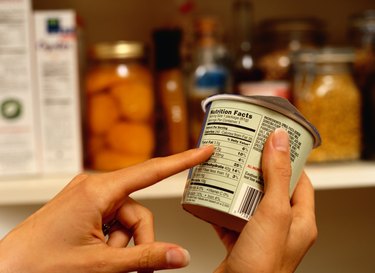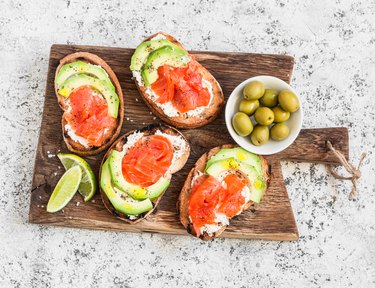
From your friend's impressive collection of low-carb recipes to your coworker's perfectly prepped high-protein lunches, focusing on macronutrients is more popular than ever. But outside of the role they play in the latest diet trends, how much do you really know about macros?
Simply put, macros are the crucial nutrients our bodies need. There are only three to remember, and you've probably already heard of them: fat, protein and carbohydrates. Your body gets its much-needed calories — which give you energy — from the macros in the foods you eat.
It can be easy to idolize one macro and vilify another, but in reality each one comes with both pros and cons. Nutrition is nuanced. But while distinguishing between the nutritionally "good" and "bad" might seem complicated, it's actually pretty simple once you know what to look for in a nutrition facts label.
Whether you're looking to lose weight, build muscle or just eat healthier, this guide will help you become a nutrition whiz so you can master your macros and take charge of your diet with confidence.
Decoding a Nutrition Label

There's no such thing as one-size-fits-all when it comes to macro ratios: While your friend may benefit from eating 45 percent carbs, 20 percent fat and 35 percent protein, you might be better off with a different breakdown.
So how do you know how many grams of healthy fats, fiber-rich carbs and lean proteins should fill your plate? Learning each macro's unique value is a key part of planning for and adhering to a healthy diet, but it all begins with understanding nutrition labels.
Think of the label as a cheat sheet to a food product's nutritional value. Going low-carb? The nutrition label can help you figure out if you're getting enough fiber. Following a restricted-calorie diet? The label can help you calculate a serving size so you can master portion control and finally drop those last five pounds.
Get your macro ratios right by learning how to read a nutrition label once and for all.
The 411 on Calories

You know that if you eat more of them, you might add inches to your waistline. But calories are involved in a lot more than just your weight. Calories (you might also see them listed as "kcal") are a unit of measurement, sort of like an inch or a teaspoon, that quantify the amount of energy in your food and drinks. Calories actually rev your metabolism by combining with oxygen to release the energy your body needs to function.
While counting calories can help with weight loss, knowing that number alone doesn't give you all the information you need to eat well. You've got to understand the value of a calorie to know why foods labeled "low-calorie" may not always be the right choice.
Calculate your ideal daily calorie intake to make reaching to your weight-loss goals much easier.
Fat Is the New Fuel

Gone is the low-fat craze of the '80s and '90s: Praising avocados, nuts and cheese is in! Your body uses fat for energy, but the macro offers so many more perks than just that. Did you know fat keeps your hair lush and skin supple? Or that your body can only absorb certain vital nutrients when they're paired with fat?
Sounds great — but doesn't eating fat make you gain fat? The short answer: No, as long as you're eating it in moderation as part of a balanced diet. But that doesn't give you the green light to buy all the bacon. Certain types of fats are worth eating more often than others, and you'll want to replace saturated and trans fats with nourishing unsaturated fats to help curb your appetite, keep your heart healthy and support weight loss.
Learn which types of fat can either make or break your diet.
Got Protein?

Chances are the first things that come to mind when you think of protein are bulky biceps and washboard abs. Sure, the muscle-building macro can help you make gym gains, but it's so much more than that: Protein is actually the building block of life.
The 20 components of protein (aka amino acids) are responsible for regulating your sleep cycle, strengthening your immune system and even growing strong hair and nails, among other crucial functions. What's more, protein may be able to help you get — and stay — lean by keeping you feeling full for longer and slowing down Mother Nature's ill effects on muscle mass as we age.
Not all protein sources weigh equally on the nutrition scale, so make sure you're choosing the best protein for you.
To Carb or Not to Carb

Have you stocked up on cauliflower rice and canceled your beloved Sunday bagel breakfasts? Carbs seem to have become a dietary villain lately. And it's true that refined carbs can thwart your healthy-eating efforts: Simple carbs get digested relatively quickly, leading to a short-lived burst of energy that's followed by a potential energy crash and serious cravings.
Complex carbs, on the other hand, are the hero of this story: They contain fiber, which is broken down at a steadier rate, delivering sustained energy that also keeps you feeling full for longer. So while some refined carbs are basically the nutritional equivalent of the Big Bad Wolf, high-quality, complex carbs are the brick house that can keep your health goals intact.
Find out how to incorporate healthy carbs into any diet plan.